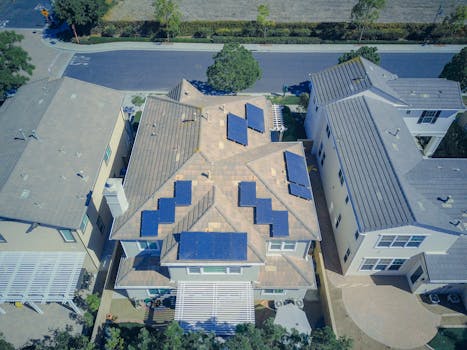“Maximize Your Energy: Real-Time Insights for Optimal Solar Battery Performance.”
Solar performance monitoring for solar battery systems involves the continuous assessment and analysis of the energy production, storage, and consumption of solar power systems equipped with battery storage. This process is crucial for optimizing the efficiency and longevity of solar installations, ensuring that the system operates at peak performance. By utilizing advanced monitoring technologies, users can track key metrics such as energy generation, battery charge and discharge cycles, and overall system health. Effective performance monitoring not only enhances energy management but also provides valuable insights for maintenance, troubleshooting, and maximizing return on investment in renewable energy solutions.
Importance Of Solar Performance Monitoring For Battery Systems
Solar performance monitoring for battery systems is an essential aspect of ensuring the efficiency and longevity of solar energy solutions. As the adoption of solar technology continues to rise, the integration of battery systems has become increasingly common, allowing users to store excess energy generated during peak sunlight hours for use during periods of low generation. However, without effective monitoring, the potential benefits of these systems can be significantly diminished. Therefore, understanding the importance of solar performance monitoring is crucial for both residential and commercial users.
One of the primary reasons for implementing performance monitoring is to optimize energy usage. By continuously tracking the performance of solar panels and battery systems, users can gain insights into their energy production and consumption patterns. This data enables them to make informed decisions about energy usage, such as when to draw power from the battery versus when to rely on solar generation. Consequently, this optimization can lead to reduced energy costs and improved overall efficiency, maximizing the return on investment for solar installations.
Moreover, performance monitoring plays a vital role in identifying potential issues before they escalate into significant problems. Solar battery systems, like any technology, can experience malfunctions or inefficiencies over time. By utilizing monitoring tools, users can detect anomalies in energy production or battery performance, such as unexpected drops in output or irregular charging cycles. Early detection of these issues allows for timely maintenance or repairs, ultimately extending the lifespan of both the solar panels and the battery system. This proactive approach not only saves money on costly repairs but also ensures that the system operates at peak performance.
In addition to optimizing energy usage and facilitating early problem detection, performance monitoring also enhances the overall reliability of solar battery systems. With real-time data at their fingertips, users can track the health of their systems and make adjustments as needed. For instance, if a battery is not charging efficiently, users can investigate the cause, whether it be a faulty connection, shading on solar panels, or a need for system recalibration. This level of oversight fosters a sense of control and confidence in the technology, encouraging users to rely on their solar systems as a dependable energy source.
Furthermore, performance monitoring can provide valuable insights into the environmental impact of solar battery systems. By analyzing data on energy production and consumption, users can better understand their carbon footprint and the extent to which they are contributing to renewable energy goals. This information can be particularly beneficial for businesses looking to enhance their sustainability initiatives, as it allows them to showcase their commitment to reducing greenhouse gas emissions and promoting clean energy solutions.
Lastly, as the solar industry continues to evolve, performance monitoring is becoming increasingly sophisticated. Advanced technologies, such as artificial intelligence and machine learning, are being integrated into monitoring systems, providing users with predictive analytics and automated alerts. These innovations not only enhance the user experience but also contribute to the overall efficiency and effectiveness of solar battery systems.
In conclusion, the importance of solar performance monitoring for battery systems cannot be overstated. By optimizing energy usage, facilitating early problem detection, enhancing reliability, providing insights into environmental impact, and leveraging advanced technologies, performance monitoring serves as a critical component in maximizing the benefits of solar energy solutions. As more individuals and businesses turn to solar power, investing in robust monitoring systems will be essential for ensuring that these technologies deliver on their promise of sustainability and efficiency.
Key Metrics To Track In Solar Battery Performance

When it comes to solar battery systems, understanding their performance is crucial for maximizing efficiency and ensuring a reliable energy supply. To achieve this, several key metrics should be monitored regularly. These metrics not only provide insights into the operational health of the system but also help in making informed decisions regarding maintenance and upgrades.
One of the primary metrics to track is the state of charge (SoC). This indicates the current energy level of the battery relative to its total capacity. Monitoring SoC is essential because it helps users understand how much energy is available for use at any given time. A well-managed SoC can prevent overcharging and deep discharging, both of which can significantly shorten the lifespan of the battery. Therefore, keeping a close eye on this metric allows for better energy management and ensures that the battery operates within its optimal range.
Another critical metric is the depth of discharge (DoD). This measures the percentage of the battery that has been discharged relative to its total capacity. Understanding DoD is vital because it directly impacts the battery’s longevity. Most batteries have a recommended DoD limit, and consistently exceeding this limit can lead to premature failure. By tracking DoD, users can adjust their energy consumption patterns and charging schedules to prolong the life of their solar battery systems.
In addition to SoC and DoD, monitoring the round-trip efficiency of the battery is essential. This metric reflects the ratio of energy output to energy input, essentially measuring how much energy is lost during the charging and discharging processes. A higher round-trip efficiency indicates a more effective battery system, as it means less energy is wasted. By keeping track of this metric, users can identify potential issues, such as degradation or inefficiencies, that may require attention.
Furthermore, temperature plays a significant role in battery performance. Batteries operate best within a specific temperature range, and deviations from this range can lead to reduced efficiency and lifespan. Therefore, monitoring the operating temperature of the battery is crucial. If temperatures are consistently too high or too low, it may be necessary to implement cooling or heating solutions to maintain optimal performance.
Another important metric to consider is the cycle count, which refers to the number of complete charge and discharge cycles the battery has undergone. Each cycle contributes to the overall wear and tear of the battery, and most batteries have a specified cycle life. By tracking the cycle count, users can anticipate when their battery may need replacement or servicing, thus avoiding unexpected downtime.
Lastly, it is beneficial to monitor the overall health of the battery system. This can include tracking voltage levels, current flow, and any error codes that may arise. Regularly assessing these parameters can help identify potential issues before they escalate into significant problems.
In conclusion, effective solar performance monitoring for battery systems hinges on tracking key metrics such as state of charge, depth of discharge, round-trip efficiency, temperature, cycle count, and overall health. By diligently monitoring these aspects, users can ensure their solar battery systems operate efficiently, extend their lifespan, and ultimately contribute to a more sustainable energy future.
Best Tools And Software For Solar Performance Monitoring
In the rapidly evolving landscape of renewable energy, solar performance monitoring has become an essential component for optimizing the efficiency and longevity of solar battery systems. As more homeowners and businesses invest in solar technology, the need for effective tools and software to monitor performance has grown significantly. These tools not only provide insights into energy production and consumption but also help in identifying potential issues before they escalate into costly problems.
One of the most widely recognized tools in the solar performance monitoring arena is the Solar-Log. This software offers comprehensive monitoring capabilities, allowing users to track the performance of their solar battery systems in real-time. With its user-friendly interface, Solar-Log provides detailed reports on energy generation, consumption, and battery status, enabling users to make informed decisions about their energy usage. Furthermore, it supports multiple inverter brands, making it a versatile choice for various solar setups.
Another noteworthy option is Enphase Enlighten, which is particularly popular among users of Enphase microinverters. This platform not only monitors the performance of individual solar panels but also provides insights into battery performance. The ability to analyze data at such a granular level allows users to pinpoint inefficiencies and optimize their systems accordingly. Additionally, Enlighten’s mobile app ensures that users can access their performance data anytime, anywhere, enhancing the overall user experience.
For those seeking a more integrated approach, Sense offers a unique solution that combines solar performance monitoring with home energy management. By using advanced machine learning algorithms, Sense can identify and track the energy consumption of individual appliances in real-time. This capability allows users to understand how their solar battery systems interact with their overall energy usage, providing a holistic view of energy management. The insights gained from Sense can lead to more efficient energy consumption patterns, ultimately maximizing the benefits of solar investments.
Moreover, the SolarEdge monitoring platform is another powerful tool that deserves mention. Known for its robust performance monitoring capabilities, SolarEdge provides users with detailed insights into their solar battery systems, including energy production, consumption, and battery health. The platform’s ability to send alerts for any performance issues ensures that users can address problems promptly, thereby minimizing downtime and maximizing energy savings. Additionally, SolarEdge’s compatibility with various third-party applications enhances its functionality, making it a flexible choice for many users.
Transitioning to a more advanced option, the Tigo Energy platform offers module-level monitoring that allows users to track the performance of each solar panel individually. This level of detail is invaluable for identifying underperforming panels and optimizing overall system efficiency. Tigo’s software also integrates seamlessly with various inverter brands, providing users with a comprehensive view of their solar battery systems.
In conclusion, the best tools and software for solar performance monitoring are essential for anyone looking to maximize the efficiency and longevity of their solar battery systems. With options like Solar-Log, Enphase Enlighten, Sense, SolarEdge, and Tigo Energy, users have access to a range of features that cater to different needs and preferences. By leveraging these advanced monitoring solutions, users can not only enhance their understanding of energy production and consumption but also ensure that their solar investments yield the maximum possible returns. As the solar industry continues to grow, the importance of effective performance monitoring will only increase, making these tools indispensable for both residential and commercial applications.
Common Issues In Solar Battery Systems And How Monitoring Helps
Solar battery systems have become increasingly popular as more homeowners and businesses seek to harness renewable energy and enhance energy independence. However, like any technology, these systems can encounter issues that may hinder their performance. Understanding these common problems and the role of monitoring in addressing them is crucial for maximizing the efficiency and longevity of solar battery systems.
One of the most prevalent issues in solar battery systems is battery degradation. Over time, batteries naturally lose their capacity to hold a charge, which can significantly impact the overall performance of the system. Factors such as temperature fluctuations, charging cycles, and depth of discharge can accelerate this degradation. By implementing a robust monitoring system, users can track the health of their batteries in real-time, allowing them to identify patterns and make informed decisions about maintenance or replacement before performance declines become critical.
Another common issue is improper charging. Solar batteries require specific charging protocols to function optimally. If a battery is consistently overcharged or undercharged, it can lead to reduced efficiency and a shorter lifespan. Monitoring systems can provide valuable insights into charging patterns, enabling users to adjust their solar energy management strategies accordingly. For instance, if monitoring data indicates that a battery is frequently overcharged, users can modify their solar inverter settings or adjust their energy consumption habits to prevent damage.
In addition to battery health and charging issues, users may also face challenges related to system integration. Solar battery systems often work in conjunction with solar panels, inverters, and other components. If any part of the system is not functioning correctly, it can lead to inefficiencies or even system failures. Monitoring solutions can help identify integration issues by providing a comprehensive view of the entire system’s performance. By analyzing data from various components, users can pinpoint the source of a problem and take corrective action, ensuring that all parts of the system work harmoniously.
Moreover, environmental factors can also impact the performance of solar battery systems. For example, extreme temperatures can affect battery efficiency and lifespan. Monitoring systems can track environmental conditions and correlate them with battery performance, allowing users to understand how external factors influence their systems. This information can be invaluable for making adjustments, such as relocating batteries to more temperature-controlled environments or investing in additional insulation.
Another critical aspect of monitoring is its role in enhancing energy management. By providing real-time data on energy production, consumption, and storage, monitoring systems empower users to optimize their energy usage. For instance, if monitoring reveals that energy consumption peaks during certain hours, users can adjust their habits or schedule energy-intensive tasks during times when solar production is at its highest. This proactive approach not only maximizes the use of renewable energy but also reduces reliance on grid power, ultimately leading to cost savings.
In conclusion, while solar battery systems offer numerous benefits, they are not without their challenges. Common issues such as battery degradation, improper charging, system integration problems, and environmental impacts can hinder performance. However, by leveraging advanced monitoring solutions, users can gain valuable insights into their systems, enabling them to address these issues proactively. Ultimately, effective monitoring not only enhances the performance and longevity of solar battery systems but also contributes to a more sustainable and efficient energy future.
Q&A
1. **Question:** What is solar performance monitoring for battery systems?
**Answer:** Solar performance monitoring for battery systems involves tracking and analyzing the energy production, storage, and consumption of solar energy systems equipped with batteries to ensure optimal performance and efficiency.
2. **Question:** Why is solar performance monitoring important for battery systems?
**Answer:** It is important because it helps identify issues, optimize energy usage, maximize battery lifespan, and ensure that the system is operating at its intended capacity, ultimately leading to cost savings and improved energy management.
3. **Question:** What key metrics are monitored in solar battery systems?
**Answer:** Key metrics include solar energy production, battery charge and discharge cycles, state of charge (SoC), depth of discharge (DoD), overall system efficiency, and energy consumption patterns.
4. **Question:** How can solar performance monitoring be implemented?
**Answer:** It can be implemented using specialized software and hardware solutions, such as monitoring apps, smart inverters, and energy management systems that provide real-time data and analytics on system performance.
Conclusion
Solar performance monitoring for solar battery systems is essential for optimizing energy efficiency, ensuring system reliability, and maximizing return on investment. By continuously tracking key performance indicators such as energy production, battery charge cycles, and overall system health, users can identify issues early, enhance maintenance practices, and make informed decisions about energy usage. Effective monitoring not only improves the longevity of the solar battery systems but also contributes to a more sustainable energy future by enabling better integration of renewable energy sources. Overall, robust performance monitoring is crucial for achieving the full potential of solar battery systems.




